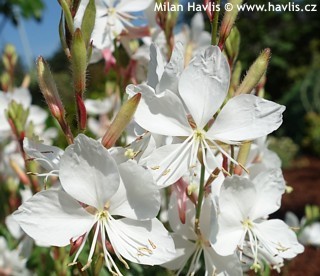Guara
(Oenothera gaura)

Description
Oenothera gaura, commonly known as Gaura or Beeblossom, is a herbaceous perennial flowering plant belonging to the family Onagraceae. Native to North America, the plant is widely grown as an ornamental plant in gardens and landscapes due to its long-lasting and showy blooms. Description Oenothera gaura is a herbaceous perennial plant that typically grows up to 1-3 feet (30-90 cm) tall, with a spread of 2-4 feet (60-120 cm). It has long, slender stems that emerge from a basal rosette of leaves. The leaves are lance-shaped and alternate along the stem, with the lower leaves being larger and the upper leaves smaller. They are green in color, and have a slightly hairy texture. The flowers of the Gaura plant are delicate, white or pink, and bloom from spring through fall. They are 1-2 inches (2.5-5 cm) wide and have four petals, giving them a star-like appearance. Overall, the plant has an airy and graceful appearance, making it a popular choice for gardens and landscapes. Habitat and Distribution Oenothera gaura is native to North America, specifically to the southeastern United States, but it can also be found in other regions of the continent. The plant can be found growing in a variety of habitats, including prairies, meadows, open woods, and along roadsides. Gaura plants are typically found in areas with well-drained soil and in full sun to partial shade. Due to its popularity as an ornamental plant, Gaura has been introduced and naturalized in many other parts of the world, including Europe, Asia, and Australia. Cultivation Gaura is relatively easy to grow and care for, making it a popular choice for gardeners and landscapers. Here are some tips for cultivating Gaura: Sunlight: Gaura plants prefer full sun to partial shade. They require at least 6 hours of direct sunlight per day in order to thrive. Soil: Gaura plants prefer well-drained soil. They can tolerate a range of soil types, including sandy or clay soil, as long as it is well-draining. If your soil is heavy, consider adding organic matter such as compost to improve drainage. Watering: Once established, Gaura plants are drought-tolerant and do not require frequent watering. However, they will benefit from occasional deep watering during prolonged periods of dry weather. Fertilization: Gaura plants do not require frequent fertilization. A light application of balanced fertilizer in the spring and summer is sufficient. Pruning: Gaura plants do not require extensive pruning. However, you can deadhead spent flowers to encourage the plant to produce more blooms. You can also cut back the entire plant in the fall to promote healthy growth in the spring. Propagation: Gaura plants can be propagated by seeds or by division. Seeds should be sown in the fall or early spring, and require a period of cold stratification in order to germinate. Division should be done in the spring or fall, and can be done every 2-3 years to keep the plant healthy and vigorous. By following these tips, you can cultivate healthy and vibrant Gaura plants in your garden or landscape. Uses Oenothera gaura has several uses: Ornamental plant: The Gaura plant is primarily grown as an ornamental plant due to its long-lasting and showy blooms. It is often used in mixed borders, as a specimen plant, or in mass plantings for a more dramatic effect. The plant also attracts bees and butterflies, making it a great choice for pollinator gardens. Medicinal purposes: The roots of the Gaura plant have been used for medicinal purposes by Native American tribes. The roots were used to make a tea that was believed to have anti-inflammatory and pain-relieving properties. Erosion control: Due to its deep root system and ability to tolerate drought, Gaura plants can be used for erosion control in areas with poor soil conditions. Wildlife habitat: The Gaura plant provides habitat and food for a variety of wildlife, including bees, butterflies, and other pollinators. In addition, there are several hybrid varieties of the Gaura plant available, which have been bred for specific traits such as flower color and size, further expanding its ornamental value. Overall, the Gaura plant is a versatile and attractive addition to any garden or landscape. Varieties There are several different cultivars of the Gaura plant available, each with its own unique characteristics. Some popular cultivars include: 'Siskiyou Pink': A compact variety with pink flowers that bloom from late spring to fall. 'Whirling Butterflies': A taller variety with white flowers that bloom from spring to fall. 'Passionate Blush': A cultivar with deep pink flowers that bloom from summer to fall. In addition to these cultivars, there are also several hybrid varieties of the Gaura plant available, which have been bred for specific traits such as flower color and size. Conservation Status The conservation status of Oenothera gaura, commonly known as Gaura or Beeblossom, has not been evaluated by the International Union for Conservation of Nature (IUCN) as it is not considered to be a threatened species. The plant is native to North America and is widely distributed throughout the continent, as well as in other parts of the world where it has been introduced as an ornamental plant. Additionally, Gaura plants are relatively easy to cultivate and propagate, and are not typically harvested for any commercial or medicinal purposes. Therefore, at present, there are no known threats to the Gaura plant and it is considered to be a species of least concern. However, it is important to monitor the plant's population and distribution to ensure its conservation and prevent any potential threats in the future. Conclusion Oenothera gaura is a beautiful and versatile plant that is well-suited for a variety of garden settings. Its long-lasting blooms, ease of cultivation, and attractiveness to pollinators make it a popular choice among gardeners and landscapers alike.
Taxonomic tree:







